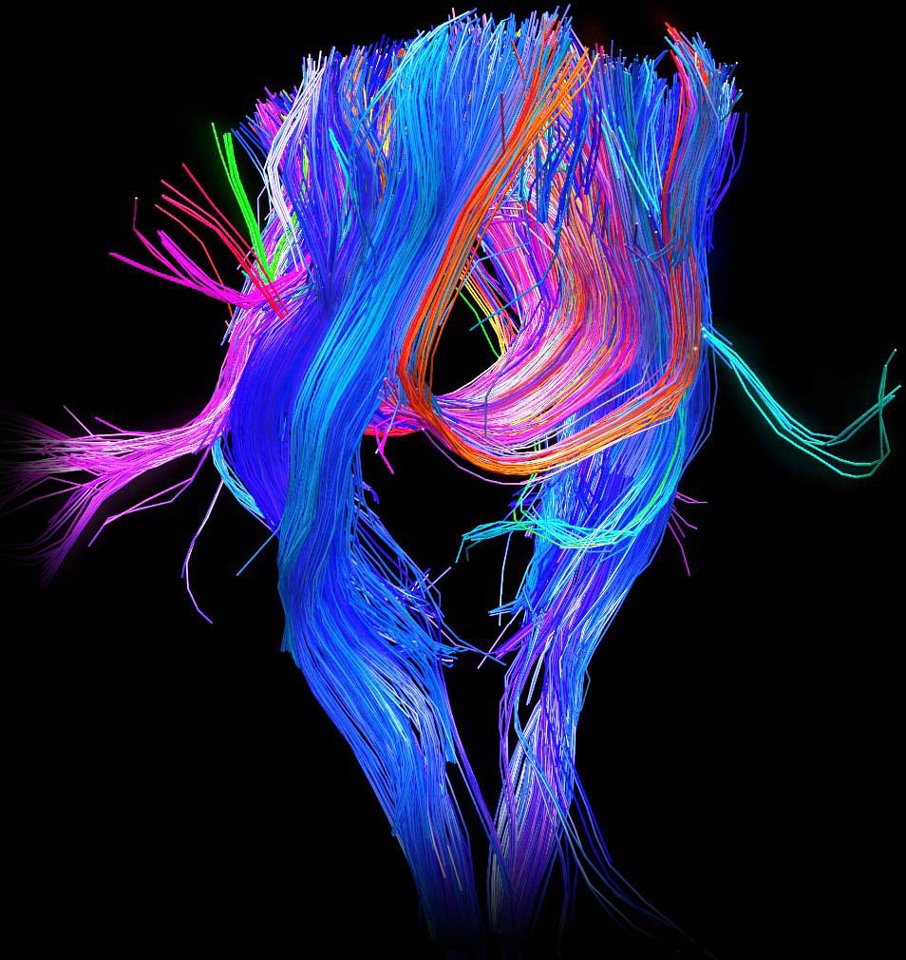

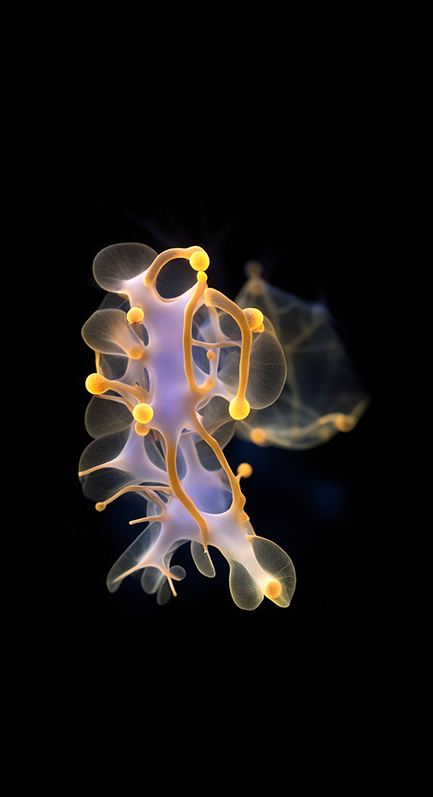
Memo Akten and Katie Peyton Hofstadter
Embodied Simulation
‘Embodied Simulation’ is a multiscreen video and sound installation that aims to provoke and nurture strong connections to the global ecosystems of which we are a part. The work combines artificial intelligence with dance and research from neuroscience to create an immersive, embodied experience, extending the viewer’s bodily perception beyond the skin, and into the environment.
The cognitive phenomenon of embodied simulation (an evolved and refined version of ‘mirror neurons’ theory) refers to the way we feel and embody the movement of others, as if they are happening in our own bodies. The brain of an observer unconsciously mirrors the movements of others, all the way through to the planning and simulating execution of the movements in their own body. This can even be seen in situations such as embodying and ‘feeling’ the movement of fabric blowing in the wind. As Vittorio Gallese writes, “By means of a shared neural state realized in two different bodies that nevertheless obey to the same functional rules, the ‘objectual other’ becomes ‘another self’.”
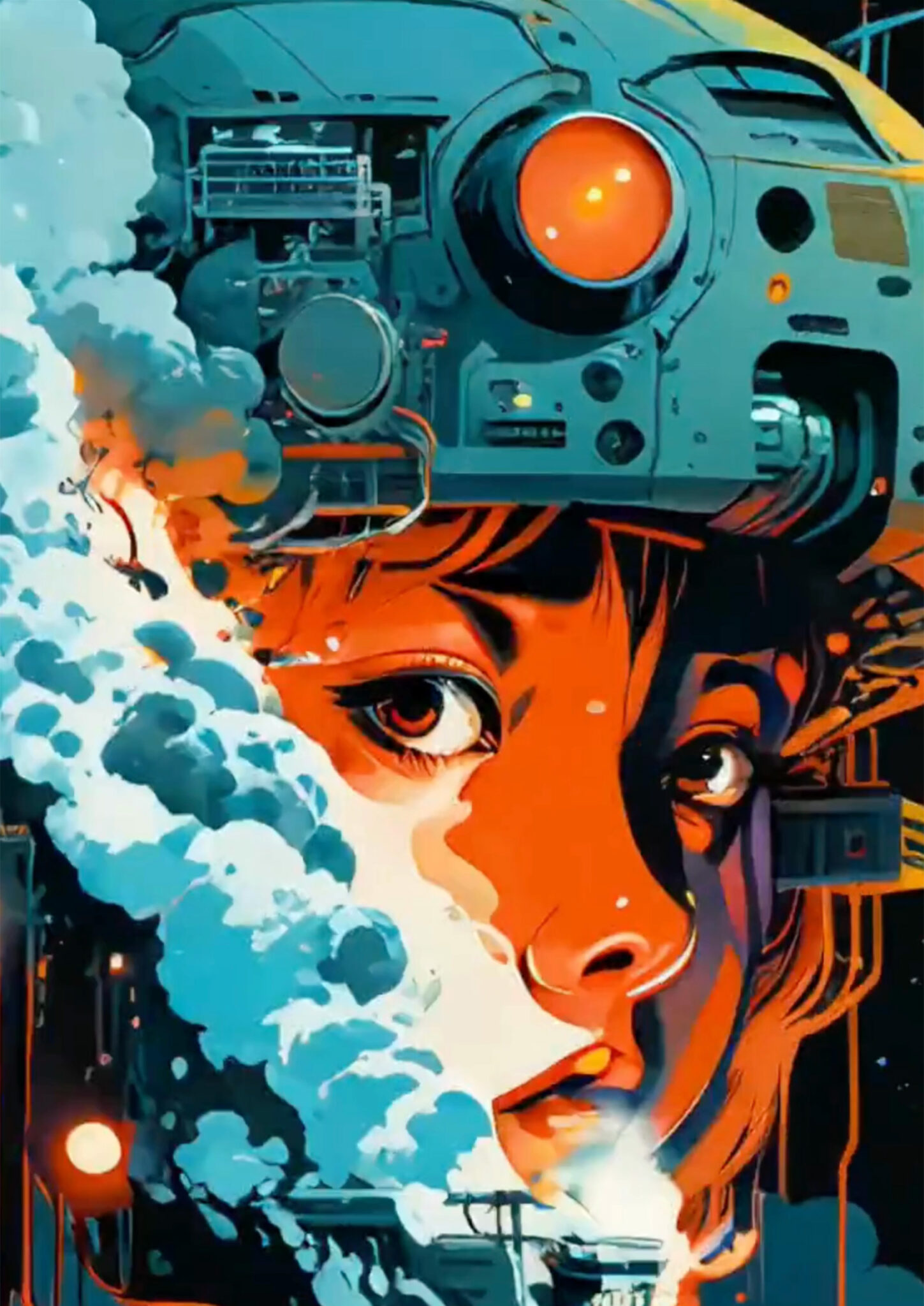
QUBIT AI: Luigi Novellino (aka PintoCreation)
Brain Entity
FILE 2024 | Interator – Sound Synthetics
International Electronic Language Festival
Luigi Novellino (aka PintoCreation) – Brain Entity – Italy
In a laboratory, a brain-like organism grows rapidly, integrating with technology and evolving into a giant entity that manipulates objects with its mind. He hypnotizes the city, absorbing energy and creating patterns. Efforts to stop him fail, signaling a battle to understand existence. This symbolizes a new era of coexistence, urging us to embrace interconnectivity and navigate a more integrated world.
Bio
Fascinated by the limitless domain of AI, Luigi Novellino adopts the title syntographer, a term that resonates deeply within the community. The artist often asks himself: “am I an artist?” Art, in his view, defies rigid definitions or limits; it represents a fluid expression of creativity that transcends labels. The artist’s ultimate goal is to awaken something in the viewer, provoking thoughts and evoking emotions.
Credits
Music: Odyssey by John Tasoulas

VTOL
ADAD
This installation is a mechanism that serves as a kind of interface between planetary processes and an audience. It consists of 12 transparent piezocrystals, grown especially for the project, and 12 motorized hammers that strike them. The installation is connected to the internet. Its core algorithm is controlled by data from a meteorological site which shows lightning strikes in real time (on average, 10~200 lightning flashes occur on the planet every minute). Each time the installation receives information about a lightning strike, a hammer strikes one of the crystals, resulting in a small electrical discharge produced by the crystal under mechanical stress. Each of these charges activates a powerful lamp and sound effects.

Jennifer Townley
Inverta
A circular axle is able to rotate by the use of 36 universal joints hanging from perspex rods and transmitting their rotary motion onto the next. In between the joints, 36 stainless steel objects are attached that rotate at the same speed as the axle. One of the objects has a slightly thinner body, making room for two integrated timing pulleys and thin cogged belts that connect it with the drive mechanism situated on the upper circular frame. The objects are made from thin sheet material and are carefully balanced by placing several counterweights inside their hollow bodies and by perforating their tails, reducing the amount of material furthest away from the axle. During the entire revolution their centre of gravity perfectly aligns with the position of the axle so that a stable rotation is ensured.

GUTO NÓBREGA
Breathing
File Festival
Breathing is a work of art based on a hybrid creature made of a living organism and an artificial system. The creature responds to its environment through movement, light and the noise of its mechanical parts. Breathing is the best way to interact with the creature.
This work is the result of an investigation of plants as sensitive agents for the creation of art. The intention was to explore new forms of artistic experience through the dialogue of natural and artificial processes. Breathing is a pre-requisite for life, and is the path that links the observer to the creature.Breathing is a small step towards new art forms in which subtle processes of organic and non-organic life may reveal invisible patterns that interconnect us.Breathing is a work of art driven by biological impulse. Its beauty is neither found isolated on the plant nor in the robotic system itself. It emerges at the very moment in which the observer approaches the creature and their energies are exchanged through the whole system. It is in that moment of joy and fascination, in which we find ourselves in a very strange dialogue, that a life metaphor is created.Breathing is the celebration of that moment.
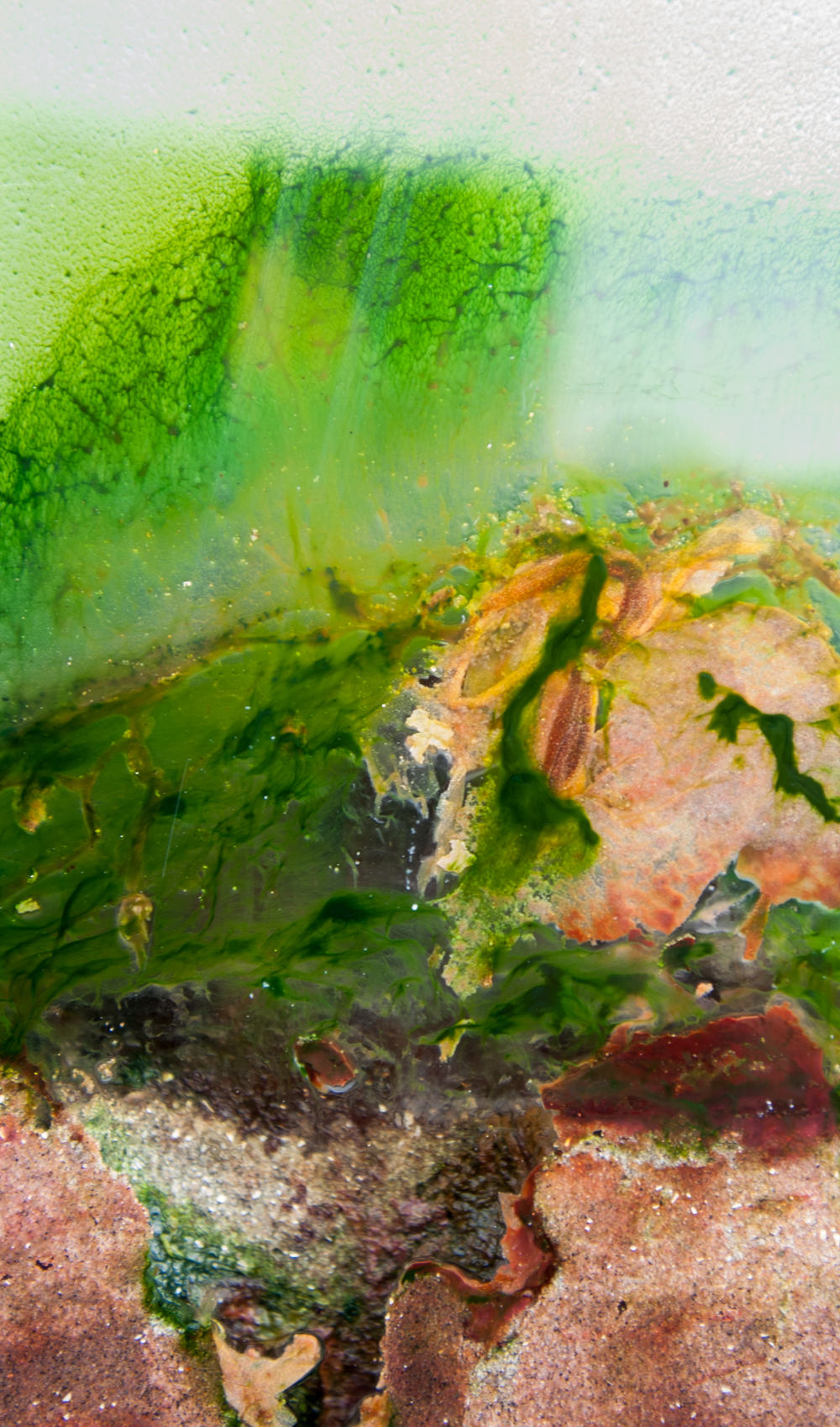
Nicole Clouston
Mud
Nicole Clouston is a practice-based researcher currently completing her PhD in Visual Art at York University. In her practice she asks: What happens when we acknowledge, through an embodied experience, our connection to a world teeming with life both around and inside us? Nicole has exhibited across Canada in Montreal, Victoria, Edmonton, and Toronto. She is currently the artist in residence at the Coalesce Bio Art Lab at the University at Buffalo.

Christian Babski, Stéphane Carion, Christophe Guignar & Patrick Keller
Satellite Daylight
Satellite Daylight is an interactive light installation formed by a trapeze of 24 high-voltage neon tubes tapering upwards, created by fabric | ch – a studio for architecture, interaction and research dedicated to investigating contemporary space based in Lausanne. The installation is connected to data collected in real time from online weather stations and meteorological satellite maps, which therefore translate actual global light conditions picked up by satellites orbiting the earth at the latitude of Basel into an endless loop of perceivable electrical intensity.

Antoni Rayzhekov and Katharina Köller
Somaphony
<somaphony> is composed of autogenous electronic objects that respond to stimuli and biofeedback wearable controllers. As it is connected with heart pulse, muscle tense, and movement of performers, real-time audiovisual visual composition is possible. The artist explores interdependence between digital equipment and performers that express behavior and cybernetic(artificial brain) relationship through this project.

Moment Factory
Animistic Imagery
The exhibit introduces visitors to Duffy, the AI Artist, with an invitation to collaborate inside her Symbiotic Studio. This immersive space, made possible through projection mapping and interactive technology, invites guests to become the AI’s muse. As Duffy captures movements generated by visitors through real-time tracking, she draws links and connections, consulting a vast collection of colors and archetypal images of life on Earth. The result is an infinite series of surprising works of art—an artificial interpretation of humanity and the natural world.
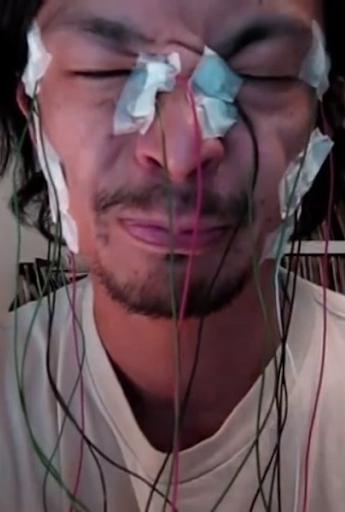
DAITO MANABE
真鍋 大 度
One of the new technology projects from the programmer and artist Daito Manabe based in Tokyo, Japan, centres on experimental music performances and connects a person’s face to electric sensors. This innovative system lets you ‘play’ your face like a musical instrument with the help of facial movements that trigger sounds. Electrical stimulation makes a face twitch involuntary, each twitch matches the beat of the music.

nieto sobejano
The Contemporary Art Center in Córdoba is not a centralized building: the center moves from one space to another, it is everywhere. It is configured as a sequence of precincts linked to a public space, onto which all the different functions of the building flow. Conceived as a place for interaction, it is a common space in which one can express and exchange ideas, see an installation, access exhibitions, visit the cafeteria, spend time in the media library, wait for a performance to begin in the black box, or maybe simply look out onto the Guadalquivir River. The materials help to achieve the art factory character pervading the entire project. In the interior, bare walls, slabs of concrete, and continuous paved flooring establish a spatial structure susceptible to being transformed individually through different interventions. A network of electric, digital, audiovisual, and lighting infrastructures ease access to sockets and connections throughout the building. On the exterior, the building asserts its presence by means of a single material: prefabricated concrete fiberglass panels, or GRC.

Asao Tokolo
ppp-creatures-generator
Asao Tokolo studied at the AA School of Architecture in London following graduation from Tokyo Zokei University in 1992. His decorative patterns based on the concept of ‘connection’ stem from September 11, 2001, and he continues to work in fields straddling art, architecture, and design. He designs and creates simple geometric crests and patterns that can be drawn with a ruler and compass, and three dimensional forms using the same principles.

JANINE ANTONI
جانين أنتوني
珍妮安东尼
ג’נין אנטוני
재닌 안토니
Жанин Антони
Mortar and Pestle
“The eye and tongue in “Mortar and pestle” could become the tongue and eye of any advanced intimate partnership.”
Since the 1990s, New York–based artist Janine Antoni has established an international reputation with labor-intensive projects in a wide range of media. She incorporates both art history and personal exploration, investigating the ways in which contemporary definitions of aesthetics and art making are connected to issues of gender identity and sexuality. Inspired by the feminist artists of the 1970s, she reframes and subverts art-historical and societal conventions surrounding women and beauty.

JANINE ANTONI
جانين أنتوني
珍妮安东尼
ג’נין אנטוני
재닌 안토니
Жанин Антони
INGROWN
Since the 1990s, New York–based artist Janine Antoni has established an international reputation with labor-intensive projects in a wide range of media. She incorporates both art history and personal exploration, investigating the ways in which contemporary definitions of aesthetics and art making are connected to issues of gender identity and sexuality. Inspired by the feminist artists of the 1970s, she reframes and subverts art-historical and societal conventions surrounding women and beauty.

Vittorio Giorgini
Walking Tall
Walking Tall was a skyscraper designed for New York in 1982-1983. The building, which was intended to rise to a height of more than 250 meters, employs asymmetric tetrahedral elements and is structurally reminiscent of utopian blueprints of the Soviet constructivist architectures of the 1920′s. Giorgini kept long-lasting friendships with the artists Jean Arp and Roberto Matta. The former artist may have left his biomorphic influences on Giorgini’s early topological architectures, while the latter artist’s dynamic three-dimension ‘inscape’ spaces may well be connected to Giorgini’s later angular works.

ALBERTO TADIELLO
taraxacum
Alberto Tadiello’s works explore the possible forms of autonomous function associated with different objects and mechanisms as they undergo a parossistic conceptualization of their own functional logic. This logic is altered and tampered in order to start reflecting upon those deeper and psychological aspects which connect people to things and technologies.

NINA MARIE BARBUTO
glory holes
Intimate friction show at the mattress factory in pittsburgh ‘glory holes’, an installation by american artist nina marie barbuto, delves into the histories of the spaces around us. the term, similarly used in hetero and homosexual copulation acts, serve as a portal for an anonymous yet intimate connection between the two bodies. as we move through the architectural space, we lose track of the larger figure, bones, and mass that surounds us.
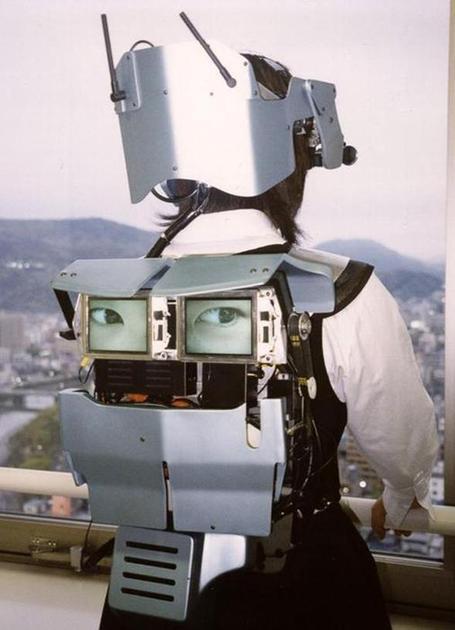
KRZYSZTOF WODICZKO
Dis-Armor Project
Dis-Armor is the newest in a series of psychocultural prosthetic equipment designed to meet the communicative need of the alienated, traumatized, and silenced residents of today’s cities. It connects contemporary research in two fields: wearable communi- cation technology and prosthetics. In doing so, it counters the dichotomy of the present explosion in communication technology and rampant cultural miscommunication. Dis-Armor offers an opportunity for indirect, mediated communication by allowing its users to speak through their backs. LCD screens, worn on the back, display live images of the wearer’s eyes transmitted from cameras installed in the helmet covering the face. A speaker positioned below the LCD screens amplifies the user’s voice. Attached to the helmet is a rearview mirror, alternatively, a rearview video camera, monitor, microphone, and headphone. These permit the user to see the face and hear the words of the spectator/interlocutor standing behind. Wireless video equipment installed in the helmet further allows two users to work in tandem, showing each other the other’s eyes and broadcasting to each the other’s voice.

SHO HASHIMOTO AND TAKASHI MATSUMOTO
pileus: internet umbrella
Pileus is an umbrella connected to the Internet to make walking in rainy days fun. Pileus has a large screen on the top surface, a built-in camera, a motion sensor, GPS, and a digital compass. The current prototype has two main functions: photo-sharing and 3D map navigation.The photo function is connected to a major web service: Flickr API. A user can take photo with a camera on the umbrella, and pictures are uploaded to Flickr in two minutes with context tags via a wireless Internet connection. User can also enjoy theirselves watching photo-streams downloaded from Flickr with simple operation of wrist snapping.
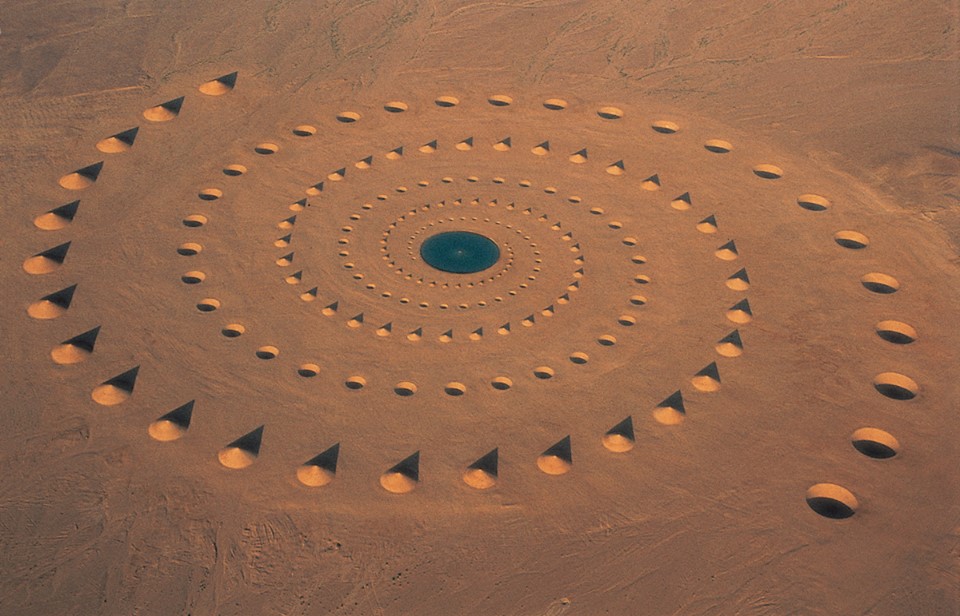
D.A.ST. ARTEAM: DANAE STRATOU AND ALEXANDRA STRATOU
Desert Breath
I imagine two parallel realities in the way that we view the world. There is the world inside and the world outside of us. It is through the senses that we are able to connect the inside to the outside world. My whole life, including the choice to become an artist, has been an attempt to re-search, to understand, and to connect these two parallel realities. To bridge what is within to what is without…
Naturally my works are triggered or have a point of departure either in the external or in the internal world. Initially, an idea is generated in the form of an internal image, which in turn needs to be answered intellectually and put into context. This process seems to me to have its point of departure in the world of the subconscious, which then surfaces into the conscious realm. Following from there, the initial idea decodes itself as it evolves into realisation and ends up ‘translating itself’ in to an artwork. It is a bit like a journey, which slowly reveals itself as I journey towards it.
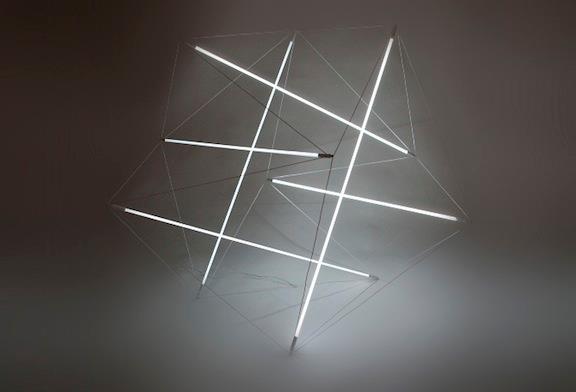
MICHAL MACIEJ BARTOSIK TENSEGRITY
lights
The tensegrity space frame light is comprised of a four strut lamp module whose geometry is the derivative of a cube. It affords a stable platonic structure with the ability to orthogonally tessellate in the x,y.z axes without change to its orientation to produce generic architectural elements such as: columns, roofs, walls and beams. Because tensegrity yields a system of structural correlation, moment force is eliminated and makes way for a high strength to weight ratio; as the system’s surface area increases, to a greater extent so too does its rigidity, allowing for generous spans and cantilevers. When arrayed, each consecutive module is pinned to the latter using its lamp connector to fasten to the mid point of an adjacent electrical tendon. The uniform array produces two distinct patterns of lamp and lattice. Where the lamps produce a luminous weave that at times resembles an orthogonal grid of offset lines, the lattice generates a sequential pattern of two distinct squares rotated at 45 degrees, one four times the size of the other.
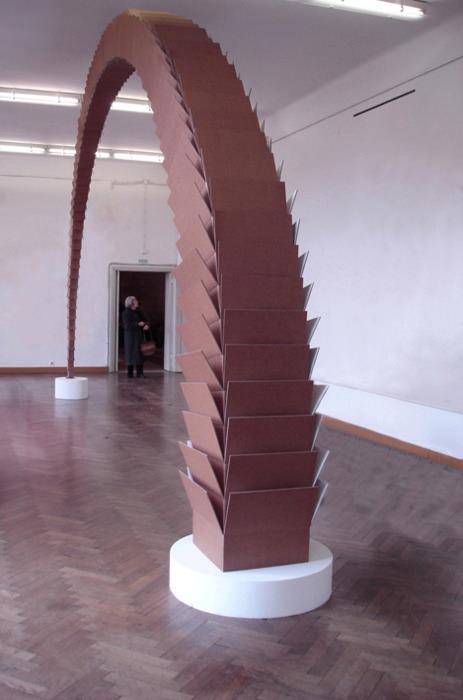

Kevin Cooley
Fallen Water
Fallen Water explores questions about why humans are drawn to waterfalls and flowing water as a source for renewal. Waterfalls imbue subconscious associations with pristine and healthy drinking water, but what happens when the fountain can no longer renew itself? Is the water no longer pure? Cooley’s choice of subject matter strikes a deep chord with current social consciousness and anxieties about contemporary water usage and the drought crisis faced by the American West. Cooley references Blake’s famous quote from The Marriage of Heaven and Hell as context for the diametric opposites of the current water conundrum: our deep sense of entitlement to and dire dependence on this precious commodity, coupled with a pervasive obliviousness concerning the sources which supply it. As a way to connect with his personal water use, Cooley hiked into the mountains to see firsthand the snowpack (or lack thereof), streams, and aquifers which feed the water sources supplying his Los Angeles home. This multi-channel installation is an amalgamation of videos made over numerous trips to remote locations in the San Gabriel Mountains, the Sierra Nevada Mountains, and locales as far away as the San Juan Mountains in Southwestern Colorado. These disconnected video vignettes coalesce, constructing a large water landscape canvasing the gallery walls and floors – reflecting the disparate and widespread origin of Los Angeles’s drinking water. The colorspace within the videos is inverted, turning the water pink, orange and yellow—channeling an altered vision of water—in which something is definitely amiss: a stark reminder of the current water crisis in the state of California.
.
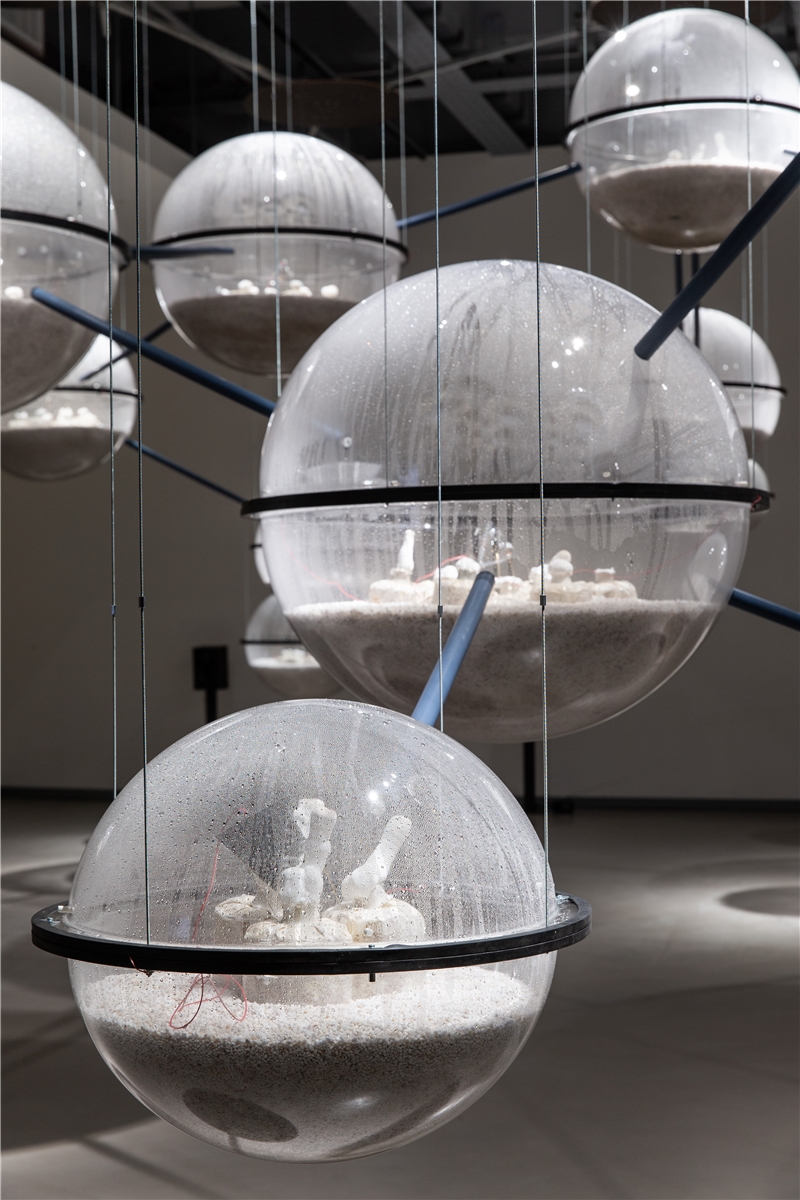
Mycelium Network Society
Franz XAVER + Taro + Martin HOWSE + Shu Lea CHEANG + global network nodes
Mycelium Network Society (MNS) investigates the unique abilities of mycelium, the collective name given to thread-like networks of fungal cells, to share and process information. Launched at the Ecologies excursion of transmediale 2017 in Berlin, in 2018 MNS takes on a franchise mode—inviting alternative art spaces and bio-hack labs to become nodes within a mycelium network, and to host workshops, residencies and exhibitions investigating mycelium, fungus and spores. Mycelium is henceforth used as a structure through which to connect co-habitants across borders, to develop channels for constant communication, to construct political tactics and contest economic collapse. The network currently comprises six nodes across France, the UK and USA, and most recently four sites in Taiwan.

Maurizio Bolognini
SMSMS-SMS Mediated Sublime
CIMs-Collective Intelligence Machines
“In 2000, I began to connect some of these computers to the mobile phone network (SMSMS-SMS Mediated Sublime, and CIMs-Collective Intelligence Machines). This enabled me to make interactive and multiple installations, connecting various locations.
In this case the flow of images was made visible by large-scale video-projections and the members of the audience were able to modify their characteristics in real time, by sending new inputs to the system from their own phones. This was done in a similar way to certain applications used in electronic democracy. What I had in mind was art which was generative, interactive and public.”

Ani Liu
Eyeris
Eyeris is a cultural prosthetic that renders the user dependent on human touch for sight. While many of today’s digital devices extend our abilities to connect with each other, disability of our current digital devices can been seen through our loss of tangible human interaction. I made this piece in trying to explore the importance of human interdependency in a society living under the myth of autonomy driven by technological symbiosis between man and computer. Eyeris is a mechanically operated electronic device powered by digital input that is deliberately over-engineered to call attention to the social behavioral conditioning imposed on us through less discreet technological devices that we assimilate on a daily basis.

Signe Lidén and Espen Sommer Eide
Vertical Studies
Vertical Studies: Acoustic Shadows and Boundary Reflections; Water Tower Sint Jansklooster In their new collaborative work, Vertical Studies: Acoustic Shadows and Boundary Reflections, Signe Lidén and Espen Sommer invite participants on a journey to a 46-metre-high abandoned water tower in Sint Jansklooster. The tower has been re-imagined as a vertical field-lab where Lidén and Sommer discuss their ongoing research into connections between sound, history, wind and weather. To this end they have constructed a range of special instruments to record and playback sounds in the vertical dimension. The participants on this journey will experience live outdoor vertical studies and a vertical soundscape shaped by Eide and Lidén that ascends the tower’s spiral staircase.

Eric Klarenbeek, Designer of the unusual
Eye Jewellery
Eric Klarenbeek does special projects, or let’s say the unusual, for unusual people, projects or purposes. His studio connects creatives, designers, local crafts and clients by inventing new projects and products and believing our world can be so much better, more beautiful and honest. “My work is characterized by interaction and innovation. My products can be in motion, react on our presence or respond on developments in our society. I search for new meaning and principles in objects, for unexplored connections between materials, production methods, makers and users. Scale and appliance are irrelevant. I’ve designed jewellery, but also developed concepts to connect tourists to local craftsmen”, says Eric.
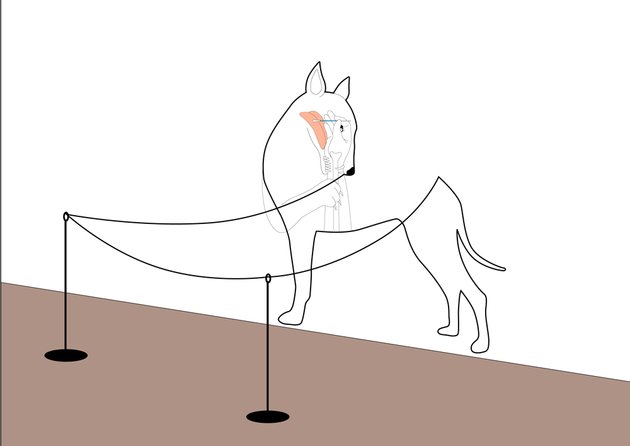
YVES NETZHAMMER
Nature, Fear, Entity
Nature, Fear, Entity sont trop importantes pour être traitées. Bien que je sois d’accord avec les sources de la douleur, elle existe inévitablement dans chaque expérience personnelle, mais je ne donnerai aucun indice détaillé, mais pour comprendre l’expérience dans un respect macro et la transformer en création. For me, transformation is a key method, sometimes when you see some scenes or chapters, seems like impossible to happen in the reality, but after a while when you think backward, probably you would feel that’s exactly how they should/originally are, an apperance after transformation. So transform becomes a very important channel to connect the interconnectness of things, to unseal some questions you would like to discuss; this is why I like to apply it often.
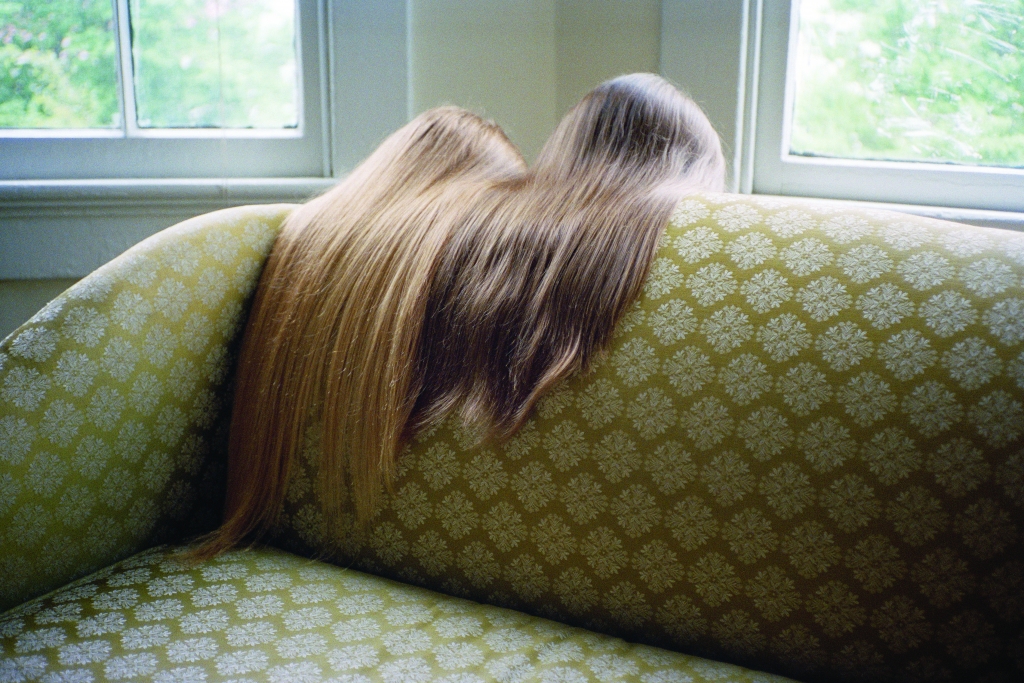
ANDREW LYMAN
Alone Together
The phrase Alone Together describes a nature of personal relationships and relating to one another that I have found to be characteristic of an experience the generation I am a part of encounters, if not others as well. The phrase in context of communication calls upon the experience and realization that your mental state is completely unique and solitary. There is a push to connect with others as well as to find someone to spend your life with, and along with this push comes the expectation of a complete and total togetherness. There is an eventual point of realization and discovery of your own mental state and its perpetual solitude, transcending physical closeness with others. The photographs in the series evoke contemplation of this experience, through imagery of the mundane, capturing a quiet departure into a somewhat bizarre disconsolate self-investigation. The photographs play with the association of Alone Together to intimacy and love, with an alternate interpretation or redefinition according to newfound phenomenon.
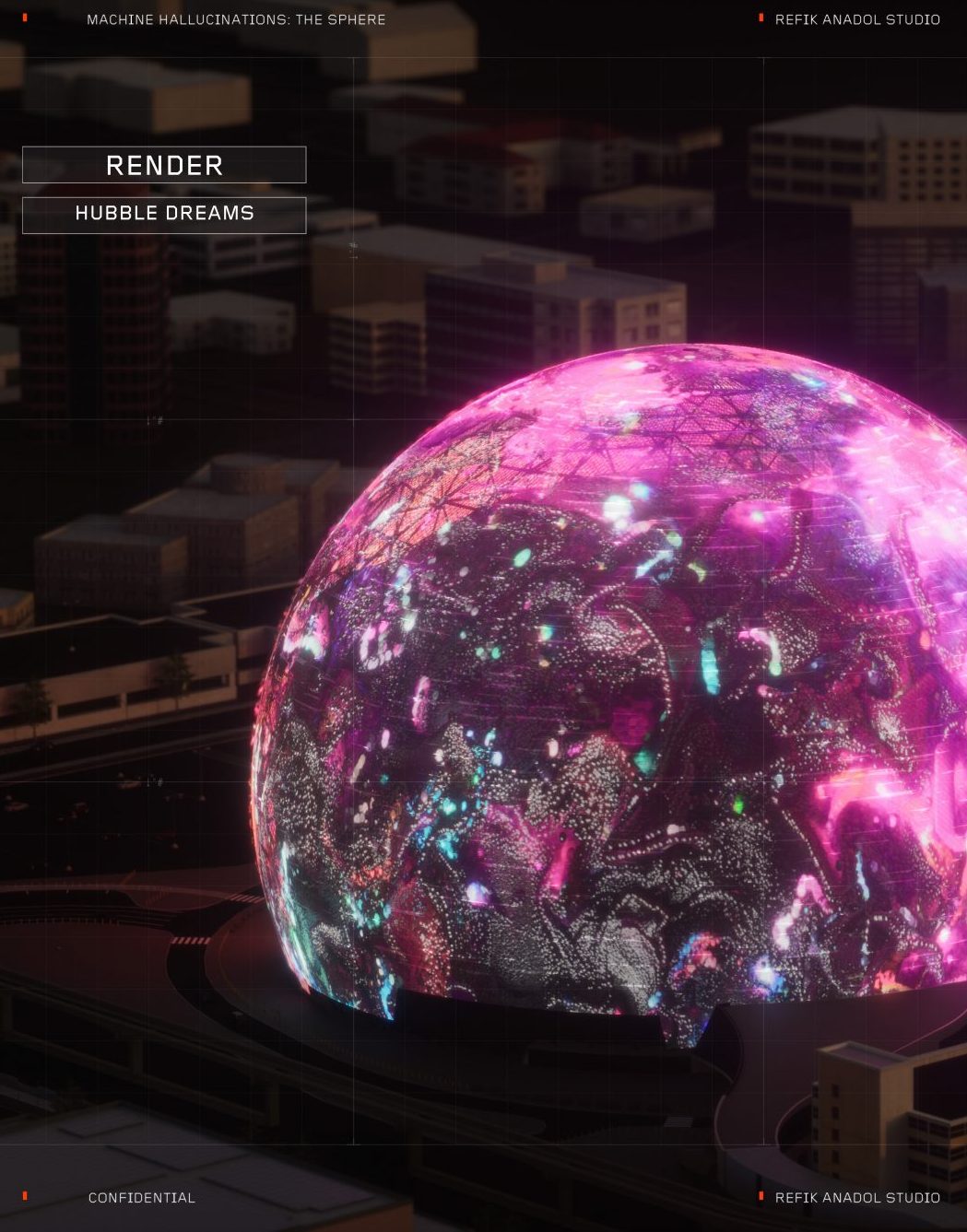
Refik Anadol
Machine Hallucinations — Sphere
The artwork presents a series of AI Data Sculptures that incorporates vivid pigments, shapes, and patterns, aiming to create a collective, meditative, and multisensory experience. This immersive experience simulates the rhythms of various environments and invites the visitors to imagine alternative realities constructed by invisible data movements around them.
Machine Hallucination: The Sphere features dynamic visualizations of data that are based on vast archives containing visual imageries of space and nature while celebrating the unique architecture of The Sphere. For this project, Anadol and his team used these themed datasets as the building blocks for the three distinct chapters of the artwork and trained a unique AI model with subsets of the collected image archives. After the training, when idle and unsupervised, the “machine mind” generates new aesthetic visuals and color combinations through unique lines drawn by algorithmic connections.

BREAKFAST
Interwoven Existence
The artwork draws inspiration from the concept that individual human beings are interconnected rather than isolated. It is a visual representation of collective strength and diversity. The artwork is divided into sections of various sizes and colors, each symbolizing the diverse origins of people around the world.
As viewers approach the artwork, it becomes interactive, reflecting their image across the piece. Upon stepping away, a recording of their interaction is placed into one of the sections, symbolizing the randomness of a given person’s birthplace and socioeconomic position. Subsequently, recorded video clips of previous viewers are displayed in adjacent sections, integrating new viewers into the existing community of participants.

ENESS
Modern Guru
Modern Guru is a translucent ovoid with four huge digital eyes, floating above a ceremonial ring of LEDs. From his mouth flows a ream of absurdist messages, and in a statement about the true nature of lived experience, a new message is delivered when visitors take a photo of Modern Guru – a missive produced only for those who seek to photograph life rather than live the moment. This immersive new media art installation uses the intersection of art and technology to explore modern paths to happiness through unique interactions with characters along a mystical journey of discovery. Visitors are asked to commit to the path – a tight and winding trail with subtle points of connection along the way – a glowing landscape of oversized, whimsical mountains that chant incantations and blink innocently from digital eyes.
Having communed with the Guru, visitors then weave their way back through this warped and strange world full of illusions and delusions, perceptions and deceptions, all the while bathing in luminescent light; embracing big, gentle forms; and following their own path up the pink tongue staircase to meet the one who oversees the whole fantastic dominion, the Sun God.

QUBIT AI – International Electronic Language Festival – Art and Technology
QUBIT AI | quantum & synthetic ai
Electronic Language International Festival
July 3rd to August 25th
Tuesday to Sunday, 10am – 8pm
FIESP Cultural Center
Design: André Lenz
Image: Iskarioto Dystopian AI Films – Athena
QUBIT AI
In its 25 years of existence, the International Electronic Language Festival (FILE) is an internationally renowned Brazilian project that since 2000 has explored the intersection between art and technology. With more than two decades of history, the festival stands out for fostering exhibition spaces and debate about artistic innovations driven by disruptive and innovative technologies, inviting the public to get involved with experimental forms of art that challenge the boundaries of conventionality. Currently, two of these technologies stand out in the contemporary scenario: the accelerated development of quantum computing and artificial intelligence corroborated by synthetic data.
Quantum computing, an emerging revolution in the technological field, offers a new range of creative possibilities for contemporary artists. This new era allows the exploration of unprecedented frontiers through a new computational format that consists mainly of quantum superposition and entanglement, a new field of exploration for synthetic computer science, as well as for the arts in general; on the other hand, artificial intelligence, fueled by synthetic data, offers artists a new way of making and understanding art, opening up space for new forms, concepts and artistic expressions.
Entitled QUBIT AI, the exhibition delves into this unexplored territory presenting a selection of works of art resulting from the connection between artistic creation and technology, proposing a theoretical reflection on what the interrelationship between quantum computers and synthetic artificial intelligence will be.
Visitors will be invited to experience immersive installations, experimental videos, digital sculptures and other forms of interactive art, which intertwine reality and imagination. The exhibition encourages reflections on the influence of technology on art and contemporary society, while at the same time providing an environment to compare already established technological arts (analog and digital) with the possible futures of art in the synthetic era, enhanced by quantum computing. The QUBIT AI exhibition at FILE SP 2024 transcends the mere presentation of works of art; it is a journey to the limits of human creativity, driven by the convergence of art, science and technology.
Ricardo Barreto and Paula Perissinotto
co-organizers and curators of FILE
International Electronic Language Festival

QUBIT AI: AESTHETIC SYNTHETIC FILE – São Paulo 2024 – Art and Technology
FILE 2024
QUBIT AI | quantum & synthetic ai
Electronic Language International Festival
July 3rd to August 25th
Tuesday to Sunday, 10am – 8pm
FIESP Cultural Center
Design: André Lenz
Image: Iskarioto Dystopian AI Films – Athena
QUBIT AI
In its 25 years of existence, the International Electronic Language Festival (FILE) is an internationally renowned Brazilian project that since 2000 has explored the intersection between art and technology. With more than two decades of history, the festival stands out for fostering exhibition spaces and debate about artistic innovations driven by disruptive and innovative technologies, inviting the public to get involved with experimental forms of art that challenge the boundaries of conventionality. Currently, two of these technologies stand out in the contemporary scenario: the accelerated development of quantum computing and artificial intelligence corroborated by synthetic data.
Quantum computing, an emerging revolution in the technological field, offers a new range of creative possibilities for contemporary artists. This new era allows the exploration of unprecedented frontiers through a new computational format that consists mainly of quantum superposition and entanglement, a new field of exploration for synthetic computer science, as well as for the arts in general; on the other hand, artificial intelligence, fueled by synthetic data, offers artists a new way of making and understanding art, opening up space for new forms, concepts and artistic expressions.
Entitled QUBIT AI, the exhibition delves into this unexplored territory presenting a selection of works of art resulting from the connection between artistic creation and technology, proposing a theoretical reflection on what the interrelationship between quantum computers and synthetic artificial intelligence will be.
Visitors will be invited to experience immersive installations, experimental videos, digital sculptures and other forms of interactive art, which intertwine reality and imagination. The exhibition encourages reflections on the influence of technology on art and contemporary society, while at the same time providing an environment to compare already established technological arts (analog and digital) with the possible futures of art in the synthetic era, enhanced by quantum computing. The QUBIT AI exhibition at FILE SP 2024 transcends the mere presentation of works of art; it is a journey to the limits of human creativity, driven by the convergence of art, science and technology.
Ricardo Barreto and Paula Perissinotto
co-organizers and curators of FILE
International Electronic Language Festival
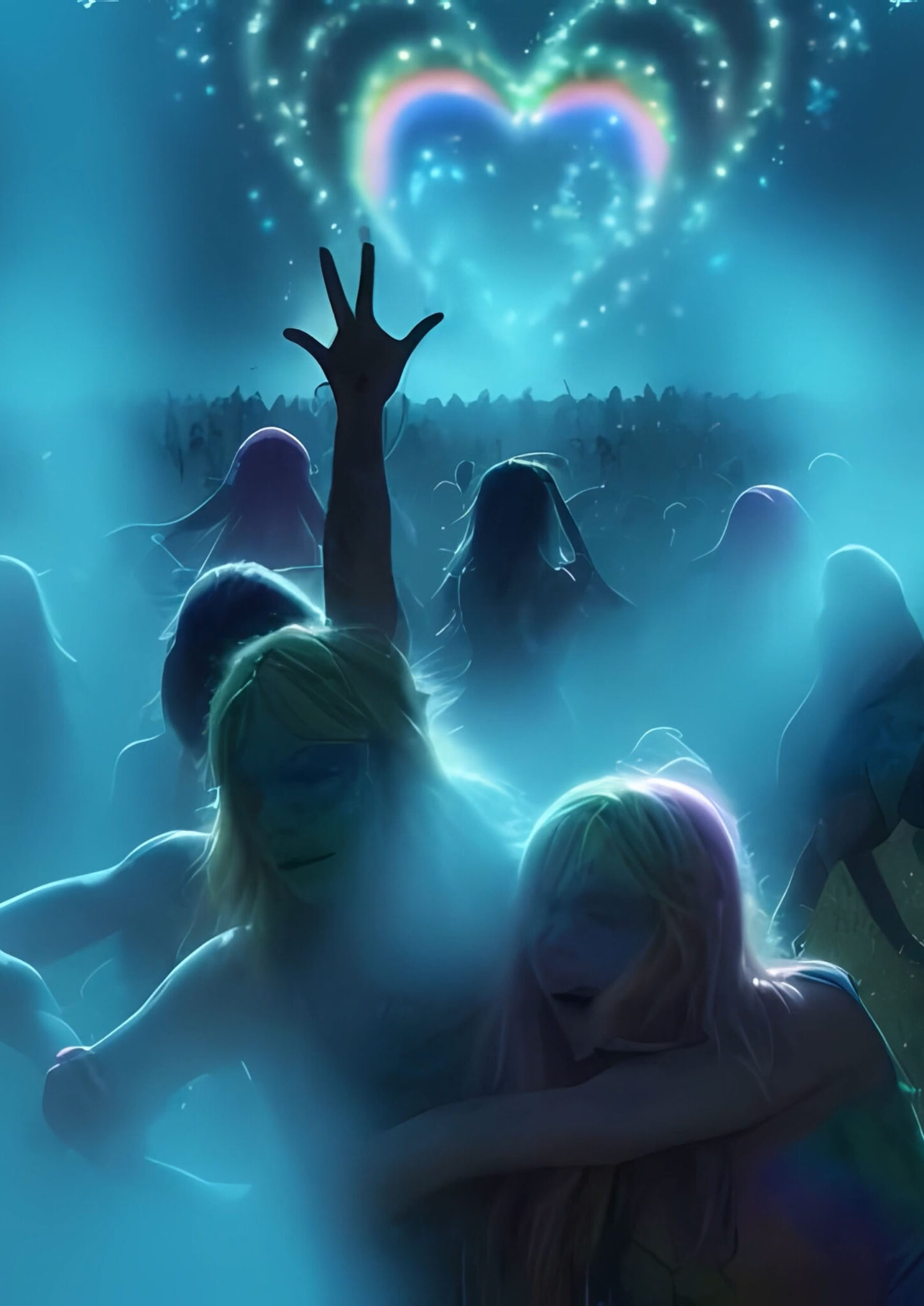
QUBIT AI: Dennis Schöneberg
N-DRA
FILE 2024 | Interator – Sound Synthetics
International Electronic Language Festival
Dennis Schöneberg – N-DRA – Germany
Created during the pandemic, N-DRA is a video that explores the nostalgia of pre-pandemic times. Through a dreamlike and psychedelic journey through the artist’s memories, it reflects feelings of loneliness, isolation and the desire for connection.
Bio
Dennis Schöneberg, German AI artist, data science student and developer of open source AI models, integrates his passion for electronic music into his creative endeavors. Merging art with technology, he explores the synergy between creativity and artificial intelligence.
Credits
Music: N-DRA by Ricardo Villalobos

QUBIT AI: FILE QUANTUM WORKSHOP 2024 – São Paulo – Art and Technology
FILE 2024
QUBIT AI | quantum & synthetic ai
Electronic Language International Festival
July 3rd to August 25th
Tuesday to Sunday, 10am – 8pm
FIESP Cultural Center
Design: André Lenz
Image: Iskarioto Dystopian AI Films – Athena
QUBIT AI
In its 25 years of existence, the International Electronic Language Festival (FILE) is an internationally renowned Brazilian project that since 2000 has explored the intersection between art and technology. With more than two decades of history, the festival stands out for fostering exhibition spaces and debate about artistic innovations driven by disruptive and innovative technologies, inviting the public to get involved with experimental forms of art that challenge the boundaries of conventionality. Currently, two of these technologies stand out in the contemporary scenario: the accelerated development of quantum computing and artificial intelligence corroborated by synthetic data.
Quantum computing, an emerging revolution in the technological field, offers a new range of creative possibilities for contemporary artists. This new era allows the exploration of unprecedented frontiers through a new computational format that consists mainly of quantum superposition and entanglement, a new field of exploration for synthetic computer science, as well as for the arts in general; on the other hand, artificial intelligence, fueled by synthetic data, offers artists a new way of making and understanding art, opening up space for new forms, concepts and artistic expressions.
Entitled QUBIT AI, the exhibition delves into this unexplored territory presenting a selection of works of art resulting from the connection between artistic creation and technology, proposing a theoretical reflection on what the interrelationship between quantum computers and synthetic artificial intelligence will be.
Visitors will be invited to experience immersive installations, experimental videos, digital sculptures and other forms of interactive art, which intertwine reality and imagination. The exhibition encourages reflections on the influence of technology on art and contemporary society, while at the same time providing an environment to compare already established technological arts (analog and digital) with the possible futures of art in the synthetic era, enhanced by quantum computing. The QUBIT AI exhibition at FILE SP 2024 transcends the mere presentation of works of art; it is a journey to the limits of human creativity, driven by the convergence of art, science and technology.
Ricardo Barreto and Paula Perissinotto
co-organizers and curators of FILE
International Electronic Language Festival

QUBIT AI: FILE OPENING LECTURE 2024 – São Paulo – Art and Technology
FILE 2024
QUBIT AI | quantum & synthetic ai
Electronic Language International Festival
July 3rd to August 25th
Tuesday to Sunday, 10am – 8pm
FIESP Cultural Center
Design: André Lenz
Image: Iskarioto Dystopian AI Films – Athena
QUBIT AI
In its 25 years of existence, the International Electronic Language Festival (FILE) is an internationally renowned Brazilian project that since 2000 has explored the intersection between art and technology. With more than two decades of history, the festival stands out for fostering exhibition spaces and debate about artistic innovations driven by disruptive and innovative technologies, inviting the public to get involved with experimental forms of art that challenge the boundaries of conventionality. Currently, two of these technologies stand out in the contemporary scenario: the accelerated development of quantum computing and artificial intelligence corroborated by synthetic data.
Quantum computing, an emerging revolution in the technological field, offers a new range of creative possibilities for contemporary artists. This new era allows the exploration of unprecedented frontiers through a new computational format that consists mainly of quantum superposition and entanglement, a new field of exploration for synthetic computer science, as well as for the arts in general; on the other hand, artificial intelligence, fueled by synthetic data, offers artists a new way of making and understanding art, opening up space for new forms, concepts and artistic expressions.
Entitled QUBIT AI, the exhibition delves into this unexplored territory presenting a selection of works of art resulting from the connection between artistic creation and technology, proposing a theoretical reflection on what the interrelationship between quantum computers and synthetic artificial intelligence will be.
Visitors will be invited to experience immersive installations, experimental videos, digital sculptures and other forms of interactive art, which intertwine reality and imagination. The exhibition encourages reflections on the influence of technology on art and contemporary society, while at the same time providing an environment to compare already established technological arts (analog and digital) with the possible futures of art in the synthetic era, enhanced by quantum computing. The QUBIT AI exhibition at FILE SP 2024 transcends the mere presentation of works of art; it is a journey to the limits of human creativity, driven by the convergence of art, science and technology.
Ricardo Barreto and Paula Perissinotto
co-organizers and curators of FILE
International Electronic Language Festival

SETUP
COIL
The COIL installation is a space for reflection and a feeling of connection between people. COIL resembles a teleport and with this meaning it carries the phenomenon of teleportation. It is something impossible, but the consequences of escaping into it are instantaneous movement and farewell to eternal time. Any venue with art or raves is already an attempt to escape. So COIL pulls the viewer out of chronos and opens access to the eternal.
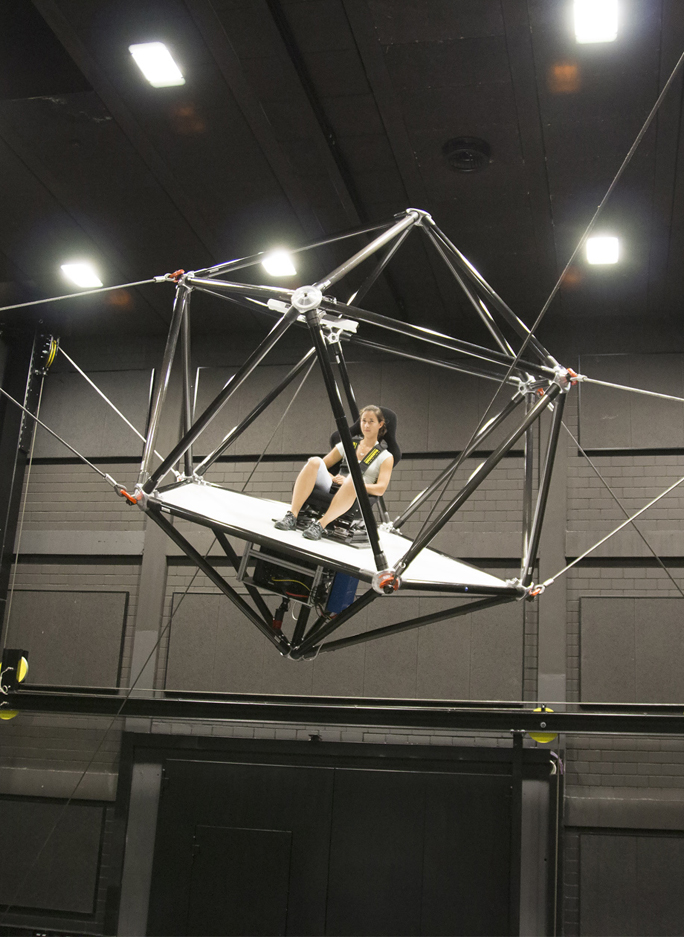
Heinrich Bulthoff
Cable Robot Simulator
Max-Planck-Institut für biologische Kybernetik
Eight steel cables, each with 1.4 tons of tensions, hold aloft a caged platform with a seat for one person. Using a wireless VR headset, that person can simulate experiences like flight while being zoomed in dozens of different ways. Eight retracting cables connected to a winch pull on the cage. It’s like a giant, flying VR jungle gym.
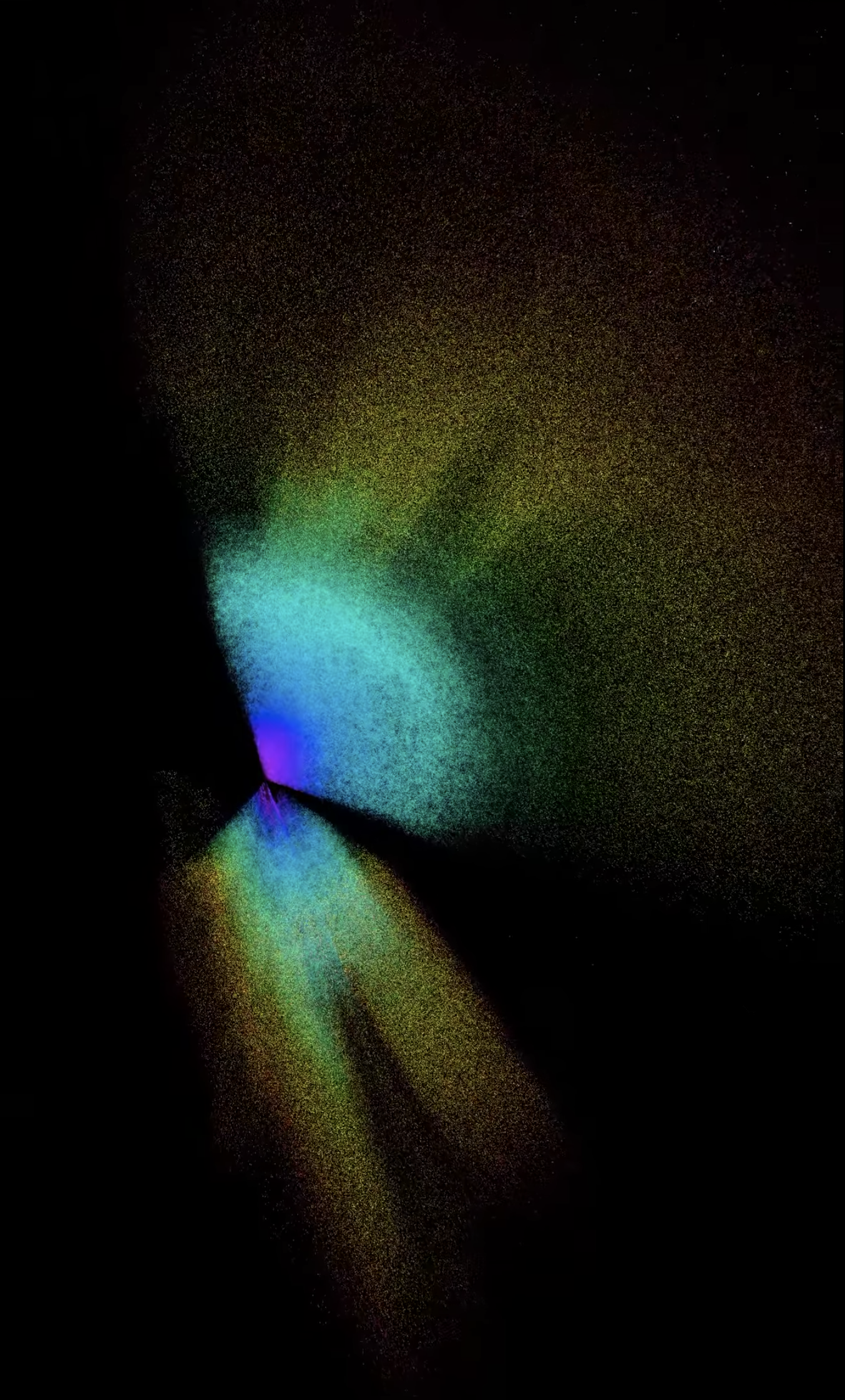
The eBOSS 3D map of the Universe
extended Baryon Oscillation Spectroscopic Survey ( eBOSS)
“Taken together, detailed analyses of the eBOSS map and the earlier SDSS experiments have now provided the most accurate expansion history measurements over the widest-ever range of cosmic time. These studies allow us to connect all these measurements into a complete story of the expansion of the Universe.” Will Percival

Caitlin Franzmann
Drawn Together, Held Apart
Caitlin is an artist that is interested in intentional social connection in public spaces. She creates experiences that allow participants to quietly communicate and listen to one another. In the live component of her installation, Caitlin hosts an conversation entitled ‘talking and listening about talking and listening’. ‘Drawn Together, Held Apart’ (2017), a custom made table with inbuilt surface transducer speaker, motion sensor activated LED lighting, proximity speakers and audio. Visitors rest their ears on the glass and listen.

Jung Hsu and Natalia Rivera
Bi0film.net
Independent and distributed communication networks are at the core of self-organized communities. Based on the idea of biological peer-to-peer networks, which explore how microorganisms like bacteria communicate and collectively act, we have built a human biofilm-like connectivity enhancer.20

Neri Oxman
MAN-NAHĀTA
Computational growth across material and urban scales offers a framework for design through self-organization, enabling the generation of vast, diverse forms exhibiting characteristics like those that emerge through the biological growth processes found in Nature. In this project, we construct an oriented volume spanned by surface normals of the shape at every point. The value of the oriented volume drives the iterative deformation of the shape. Depending on the parameterization of this process, we can obtain distinctly different growing forms. Importantly, the emergence of these forms is driven only by the time evolution of a geometric operator acting on the shapes iteratively, thereby connecting geometry and growth through an algorithm. To form the Man-Nahata landscape, the buildings of the urban landscape are transformed through repeated morphological closing operations, where the field of influence follows a gradient from the center to the outskirts of a circular region.

Studio Above&Below
‘Semi-Diurnal Spaces’ is a site specific immersive installation in form of a full dome which makes use of local tidal and atmospheric data of South Wales. Locals were invited to experience their close-by waterbody through a meditative environment, connecting to it in a poetic, technological and tele present way. Tidal patterns and atmospheric data such as wind and humidity influence a digital NVIDIA FleX particle system in real-time. The site-specific data influences the gravitational forces, fluid viscosity and flow rate within the dome as a body, resulting in a living digital sculpture and AV experience connecting to aspects of the channel itself.
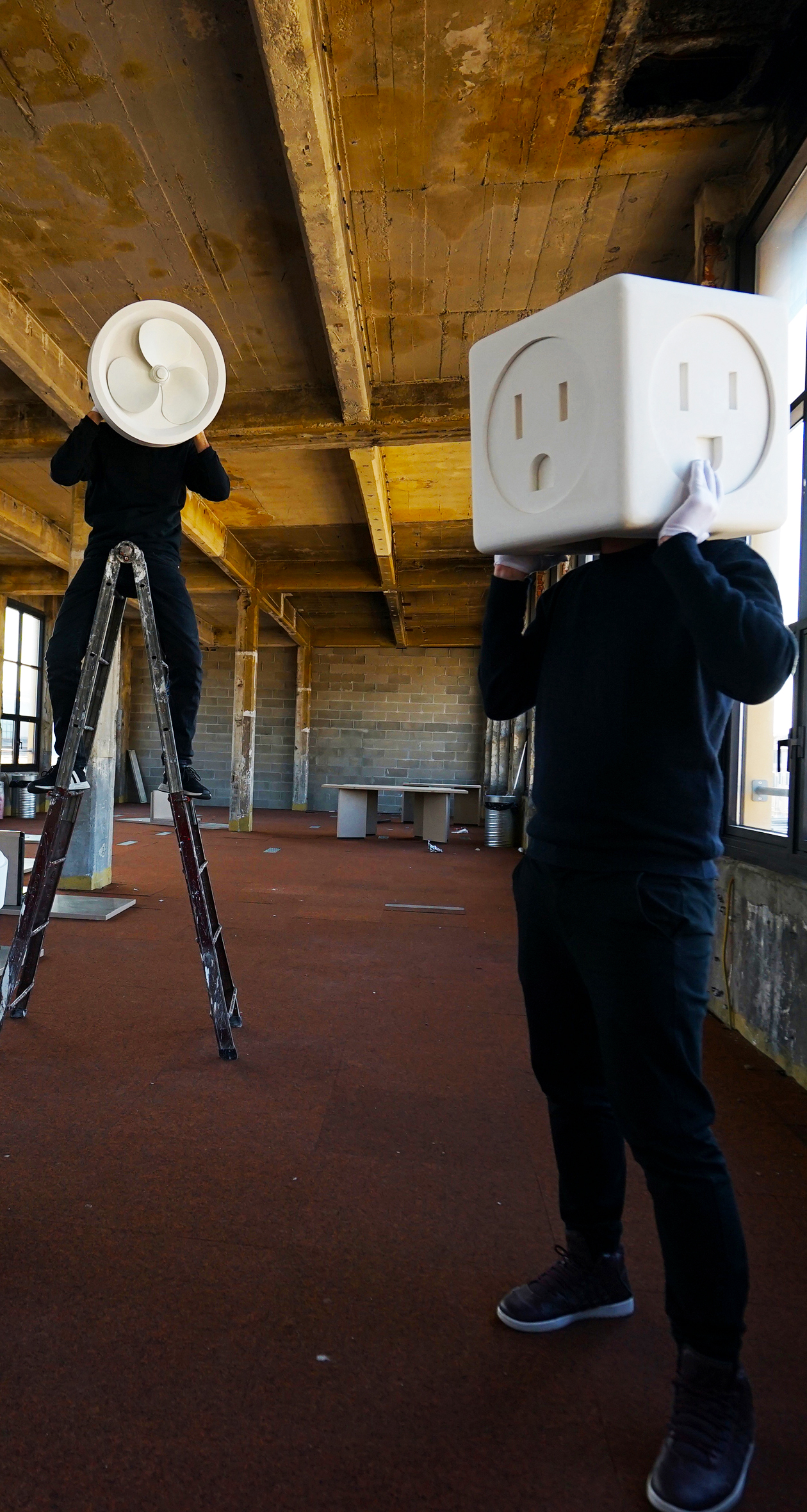
OBJECTIVE REALITIES
Ferme automatique
FILE FESTIVAL
À mesure que les choses deviennent plus intelligentes et connectées, leur rôle dans la vie des gens est remis en question. Les choses se rapprochent de plus en plus de nous, finissant par devenir elles-mêmes des «utilisateurs». Comment comprendrons-nous les besoins et les perspectives des objets et comment les concevoirons-nous?

Robert Wilson
بوب ويلسون
鲍伯·威尔逊
בוב וילסון
ロバート·ウィルソン
밥 윌슨
БОБ УИЛСОН
Arvo Pärt
Adam’s Passion
Estonian Arvo Pärt is one of the three most performed contemporary composers worldwide. His music has been described as contemplative, sacred, and timeless. “Time for us is the time of our own lives. It is temporary. What is timeless is the time of eternal life. Like the sun, we cannot look at these two directly, but my intuition tells me that the human soul is connected to both of them—time and eternity,” says Pärt. Much like Robert Wilson’s own universe, where time and space are the basic architecture of everything, it is as if these two artists have been waiting to collaborate with one another! ADAM’S PASSION will be a journey into the worlds of sound, light, visual art and performance. It will celebrate Arvo Pärt’s 80th birthday—all in a spectacular venue, the Noblessner Foundry, a vast, old industrial building by Tallinn’s harbo

SAŠA SPAČAL MIRJAN ŠVAGELJ ANIL PODGORNIK
50Myconnect
Myconnect “offers the experience of a symbiosis of connection between humans, nature and technology. The spectator becomes an actor by lying in a capsule, equipped with a helmet and body sensors measuring the variations in his rhythm This data is modulated and transmitted to a closed universe of mycelium culture (white mushroom) to produce alterations using electrical resistance. These variations in turn generate signals, sent back to the person in the form of vibration, sound and light. Each cycle can be different depending on whether the experience is stimulating or calming. This type of perceptual exchange enabled by technology reveals how much the human being is an integral part of the complex network that links him to his environment.
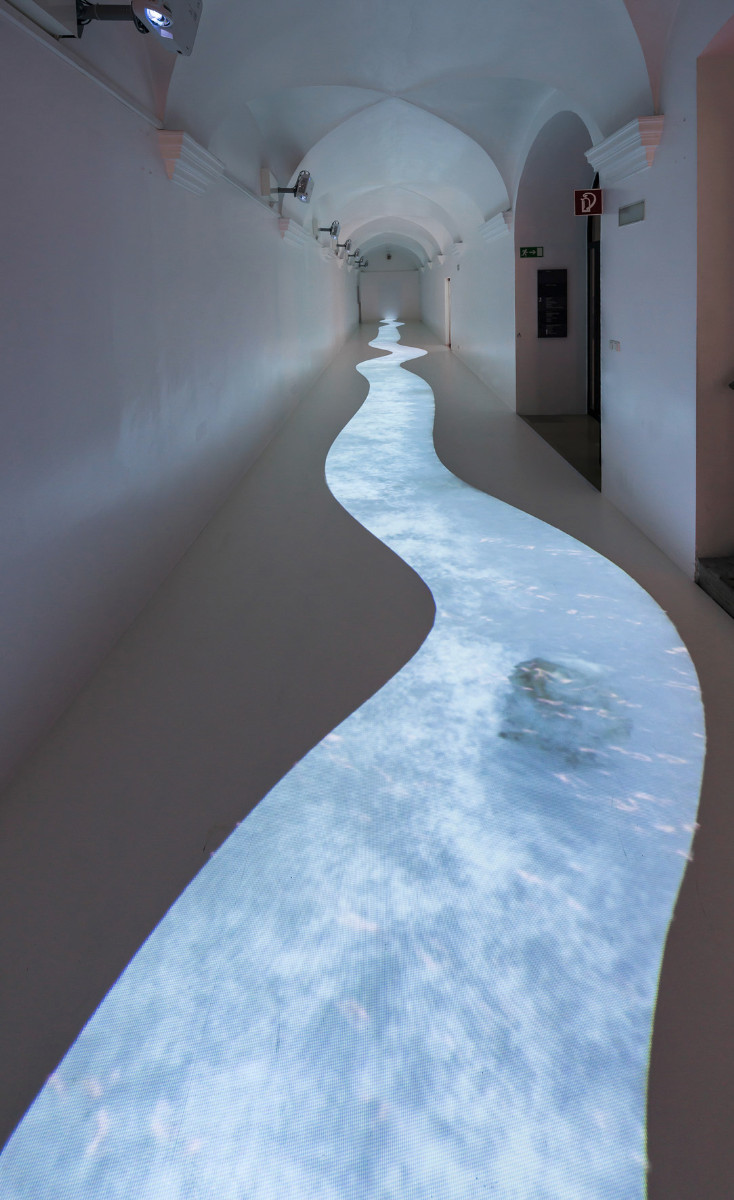
Mischa Kuball
SHALLOWS
Projection, variable size
UnTiefen (shallow waters) form the transition from the so-called Bridge Studio at the OK to the attics of the Ursulinenhof. Just as every body of water represents a natural boundary that separates and at the same time connects two shores, this flowing floor projection can also be understood as both: a path and an invitation to seek one’s own position in this transition zone.

